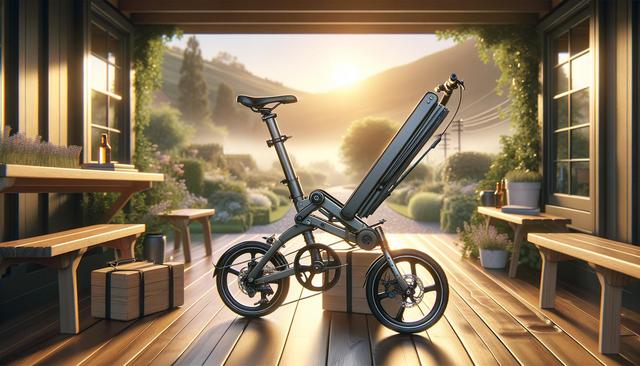What Makes Folding E-Bikes Unique?
Folding e-bikes are designed with portability and space-saving in mind, which sets them apart from other types of electric bicycles. Unlike traditional e-bikes, these models feature a frame that folds in one or more places, allowing the bike to be compacted into a smaller, more manageable size. This makes them especially suitable for individuals with limited storage space at home or work, or those who need to carry their bike on public transport. The folding mechanism is typically easy to operate and can be completed in a matter of seconds with a little practice.
One of the standout characteristics of folding e-bikes is their lightweight design, often achieved through aluminum or alloy frames. Despite their compact size, many folding e-bikes offer comparable features to full-size models, including pedal-assist modes, integrated batteries, and durable tires. Whether you commute daily or enjoy weekend rides, folding e-bikes offer a versatile alternative that doesn’t sacrifice functionality for convenience.
Benefits for Commuters and Travelers
For urban commuters, folding e-bikes offer a range of practical benefits. They are particularly appealing for multi-modal travel—combining cycling with buses, trains, or even car trips. Once folded, these bikes can fit in car trunks, under office desks, or in closets, eliminating the need for outdoor bike storage, which can be prone to theft or weather damage.
Here are a few specific advantages that appeal to frequent travelers and city dwellers:
- Easy to carry on public transport and elevators
- Compact enough for small apartments or office spaces
- Reduced risk of theft when stored indoors
- Ideal for combining with other forms of transportation
In terms of travel, folding e-bikes can be taken along in RVs, boats, or even as checked luggage on some airlines. This flexibility means you can explore new locations without relying on local transport or renting a car, making them a popular choice for adventure enthusiasts and digital nomads alike.
Comparing Folding E-Bikes to Other E-Bike Types
When exploring the different types of e-bikes, it’s important to understand how folding models compare with others like city, mountain, cargo, or hybrid e-bikes. While each type has its strengths, folding e-bikes carve out a niche for those who prioritize compactness and portability. City and hybrid e-bikes, for example, are great for smooth, paved roads and longer commutes, but they often require more storage space and are less convenient to transport.
Mountain e-bikes offer rugged performance for off-road trails but are typically heavier and bulkier. Cargo e-bikes are excellent for hauling goods or children but are not ideal for tight urban spaces due to their size. Folding e-bikes, by comparison, provide a balance between usability and storage efficiency, often with:
- Adjustable handlebars and seats for rider comfort
- Battery ranges comparable to mid-level commuter e-bikes
- Multiple folding points for increased portability
For users who don’t need advanced off-road capabilities or high-capacity cargo space, folding e-bikes present a practical and efficient option.
Key Features to Consider Before Buying
Before choosing a folding e-bike, several features should be taken into account to ensure it aligns with your specific needs. First and foremost, consider the folding mechanism itself. Some models offer a single hinge fold, while others may have multiple fold points for a more compact result. The ease of the folding process and the final folded size can significantly impact usability and storage.
Other important factors include:
- Battery range and charging time
- Motor power and pedal-assist levels
- Tire size—larger tires offer more stability, while smaller ones aid in compactness
- Weight of the bike, especially if you plan to carry it frequently
- Build quality and frame materials
Riders should also evaluate the bike’s compatibility with their daily routine. For instance, if you plan to ride on hills, a more powerful motor may be necessary. Likewise, if you’ll be folding and unfolding the bike multiple times a day, a reliable and smooth folding mechanism becomes crucial.
Who Should Choose a Folding E-Bike?
Folding e-bikes are particularly well-suited for individuals who need a flexible and portable transportation solution. They are ideal for city dwellers, office workers, students, and travelers who value the ability to store their bike in tight spaces. These bikes are also a compelling option for those who want to integrate cycling into their daily commute without the hassle of traditional bike storage or transport logistics.
Moreover, users who frequently navigate crowded streets, tight corridors, or shared living arrangements will appreciate the compact nature of these bikes. They also appeal to environmentally conscious consumers looking to reduce their carbon footprint while maintaining mobility. While not designed for extreme terrain or heavy hauling, folding e-bikes serve a specific purpose very effectively and offer a smart entry point for new e-bike users exploring the different types available.
Conclusion: Finding Your Fit in the E-Bike Landscape
Folding e-bikes offer a unique value proposition in the broader landscape of electric bicycles. Their space-saving design, portability, and ease of use make them an excellent fit for commuters, travelers, and anyone dealing with limited storage. When exploring the different types of e-bikes, folding models stand out for their adaptability and practical benefits. While they may not suit every rider’s needs, they provide a compelling option for those prioritizing convenience without compromising on mobility. Whether you’re new to e-bikes or looking to complement your existing setup, folding e-bikes deserve strong consideration as part of your decision-making process.




Leave a Reply